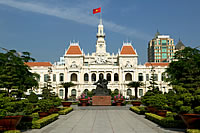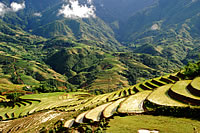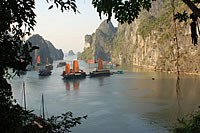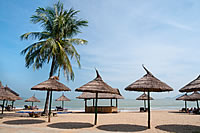Vietnam

Vietnam has an abundance of attractions, ranging from the bustling cities of Hanoi and Ho Chi Minh City to sites of natural beauty. Although many simply think of the war when they hear the name Vietnam spoken, it is a country of hidden delights.
Hanoi

The capital city of Hanoi is a good place to start a tour of Vietnam. Found on the Red River Delta, there are numerous sites where tourists can discover much of the history of the city.
For starters, there are more than 600 pagodas and temples in Hanoi. Famous sites such as the One Pillar Pagoda, the Temple of Literature and Ho Chi Minh's Mausoleum are all worth a visit, while the Old Quarter may attract those looking to delve into some local history and culture.
The city is also characterised by the 18 lakes which are dotted in and around it. In fact, water is a major feature of Hanoi, as the name means "hinterland between the rivers". As well as the main Red River and its tributaries, other waterways flow through the city, such as Duong, Cau, Ca Lo, Day, Nhue, Tich, To Lich and Kim Nguu.
Tourists can also relax by strolling around Hoam Kiem Lake, West Lake and Truc Bach Lake, or exploring their surrounding gardens and trees which are a source of energy for the city.
Ho Chi Minh City

Formerly known as Saigon, travellers will find Ho Chi Minh City in the south of the country in the core of the Mekong Delta. Those looking to avoid the rain will most likely want to head over during the dry season from December to April. The hottest month is April, but the average annual temperature stands at 27 degrees C.
Ho Chi Minh Museum is just one of the attractions on offer, while the Cu Chi Tunnels, which are a system of museums, theatres and other sites of cultural interest, are also popular with tourists. As for impressive buildings, the city is home to the National Ancestors Temple and Ho Chi Minh Municipal Theatre, along with other pagodas and churches.
Sapa

For those looking for sites of natural beauty, the mountainous area of Sapa in the district of Lao Cai province is the place to go.
In summer, tourists can feel like they have experienced four seasons in one day, with cool mornings and afternoons, sunny and cloudless conditions around noon and cold evenings. The best time to visit is in April and May, as this is when flowers are in bloom and the early morning cloud disappears to produce clear conditions.
The Ham Rong Mountain, Silver Waterfall, Rattan Bridge, Bamboo Forest and Ta Phin Cave are just some of the many natural sites worth visiting in the area. Many travellers head to Sapa as they see it as the starting point for the challenge of climbing to the top of Fansipan Mountain. Not only is it the highest mountain in Vietnam at 3,143 metres, it is also the highest in the Indochina Peninsula.
Tourists may also want to visit Sapa during Tet, the Lunar New Year Festival, when peach blossom is brought from forests just outside the town, filling the area with colour.
The markets of Sapa are also an attraction. While some people come to trade goods and products at the markets, there are other men and women in costumes looking to find a partner or simply someone to go on a date with.
Halong Bay

Another area of natural beauty in Vietnam is Halong Bay, also found in the northern part of the country. It is located in the Gulf of Tonkin and consists of 1,969 islands of varying size and shape. Such is the extent of the area's aesthetic appeal, it has been named a Unesco World Heritage Site.
One of the attractions in the area is Dau Go Grotto, which is located on Driftwood Island. Visitors will need to make their way up 90 steps to visit the site and will find the grotto is divided into three main parts.
Each chamber features fascinating rock formations and it is left up to the imagination of the visitor to interpret them. In the middle of the chamber there appears to be a monk draped in a long, dark cloak and holding a cane in his right hand. The second hollow has a mysterious quality, with the light casting images on the rock. The grotto also features an engraved stone stele which was commissioned by Emperor Khai Dinh in 1917 and praises Halong Bay.
Virgin Grotto, found on the island range of Bo Hon, is a popular place for romantic meetings. Legend has it that two star-crossed lovers were turned to stone at this location. According to the story, a beautiful fisherman's daughter was exiled to a wild island after refusing to marry the son of the rich administrator of the fishing zone. She suffered hunger and exhaustion after being banished to the island and turned to stone.
Her lover, knowing of her plight, rowed out in a boat in search of her. However, a tempest destroyed his vessel and he drifted to a nearby island where he was also petrified after suffering from exhaustion. Both are supposedly preserved in the Virgin Grotto.
Nha Trang

Tourists simply looking for somewhere to relax can head to Nha Trang, where they will find some stunning beaches and beautiful weather. Located in the Khanh Hoa province, Nha Trang is situated on the trans-Vietnam highway.
The coastal destination has the benefit of warm waters throughout the year as well as views of the archipelagos, islands, mountains and white sand beaches that surround it. Indeed, the 7km white sand beach of Nha Trang is considered to be one of the main attractions of the Vietnamese coast. Scuba diving and snorkelling are also popular here, as the waters boast an impressive coral seabed.
Holidaymakers staying in Nha Trang may also want to take a trip to Hon Tre Island. It takes two hours to reach the island on rowboat but just 20 minutes by ferry. They can additionally head out to the mountains that lie to the west of Nha Trang, where they will find some diverse wildlife.
Hue

A Unesco World Heritage Site can also be found at Hue, which is home to various areas of cultural and historical significance. It is also an ancient capital city of Vietnam.
The northern bank of the Perfume River is dotted with relics of palaces, including more than 100 architectural works which give a flavour of the life of emperors and mandarins under the Nguyen reign.
On the southern bank are the beautiful tombs of the Nguyen Kings. The four most famous are the Gia Long Tomb, Minh Mang Tomb, Tu Duc Tomb and the Khai Dinh Tomb.
Vietnam is truly a land of treasures and a wonderful destination for tourists who are interested in the fascinating history of the oriental world.